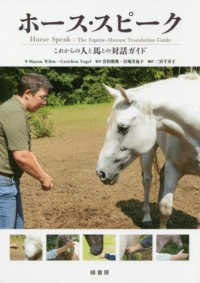- ホーム
- > 洋書
- > 英文書
- > Religion / Ethics
Full Description
This volume describes the social and practical aspects of Islamic mysticism (Sufism) across centuries and geographical regions. Its authors seek to transcend ethereal, essentialist and "spiritualizing" approaches to Sufism, on the one hand, and purely pragmatic and materialistic explanations of its origins and history, on the other. Covering five topics (Sufism's economy, social role of Sufis, Sufi spaces, politics, and organization), the volume shows that mystics have been active socio-religious agents who could skillfully adjust to the conditions of their time and place, while also managing to forge an alternative way of living, worshiping and thinking.
Basing themselves on the most recent research on Sufi institutions, the contributors to this volume substantially expand our understanding of the vicissitudes of Sufism by paying special attention to its organizational and economic dimensions, as well as complex and often ambivalent relations between Sufis and the societies in which they played a wide variety of important and sometimes critical roles.
Contributors are Mehran Afshari, Ismail Fajrie Alatas, Semih Ceyhan, Rachida Chih, Nathalie Clayer, David Cook, Stéphane A. Dudoignon, Daphna Ephrat, Peyvand Firouzeh, Nathan Hofer, Hussain Ahmad Khan, Catherine Mayeur-Jaouen, Richard McGregor, Ahmet Yaşar Ocak, Alexandre Papas, Luca Patrizi, Paulo G. Pinto, Adam Sabra, Mark Sedgwick, Jean-Jacques Thibon, Knut S. Vikør and Neguin Yavari
Contents
Contents
Acknowledgments
List of Figures
Introduction: What Is a Ṣūfī Institution? A Dichotomy in Ṣūfī Studies
Alexandre Papas
Part 1: The Economy of Sufism
1 Economies of Sufism
Adam Sabra
2 Endowments for Ṣūfīs and Their Institutions
Nathan Hofer
3 Donations to Ṣūfīs and Ṣūfī Institutions
Hussain Ahmad Khan
4 Sufism, Futuwwa, and Professional Guilds
Mehran Afshari
Part 2: Ṣūfī Places and Dwellings
5 Ṣūfī Places and Dwellings
Daphna Ephrat and Paulo G. Pinto
6 Ṣūfī Shrines
Catherine Mayeur-Jaouen
7 Ṣūfī Lodges
Peyvand Firouzeh
8 Ṣūfī Outposts (ribāṭs)
Nathan Hofer
Part 3: The Social Role of Ṣūfīs
9 The Social Role of Ṣūfīs
Rachida Chih
10 Ṣūfī Altruism
Richard McGregor
11 Sufism, Urbanisation, and Sociability in Cities
Nathalie Clayer
12 Ṣūfīs in Rural Environments
Ahmet Yaşar Ocak
Part 4: Sufism and Worldly Powers
13 Sufism and Worldly Powers
Alexandre Papas
14 Ṣūfī Terminology of Power
15 Ṣūfīs as Court Advisors
Neguin Yavari
16 Sufism, the Army, and Holy War
David Cook
17 Ṣūfī Sultanates and Imamates
Knut S. Vikør
Part 5: The Organisation of Mysticism
18 The Organisation of Mysticism
Mark Sedgwick
19 The First Communities
Jean-Jacques Thibon
20 Ṣūfī Lineages and Families
Ismail Fajrie Alatas
21 Established Ṣūfī Orders
Semih Ceyhan
22 Cyber Sufism
Stéphane A. Dudoignon
Name Index
Place Index
Thematic Index






